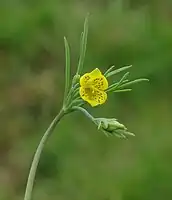| Hypecoum pendulum | |
|---|---|
_(16093152337).jpg.webp) | |
| Scientific classification | |
| Kingdom: | Plantae |
| Clade: | Tracheophytes |
| Clade: | Angiosperms |
| Clade: | Eudicots |
| Order: | Ranunculales |
| Family: | Papaveraceae |
| Genus: | Hypecoum |
| Section: | Hypecoum sect. Pendula |
| Species: | H. pendulum |
| Binomial name | |
| Hypecoum pendulum L. | |
| Synonyms | |
| |
Hypecoum pendulum is a species of flowering plant in the poppy family.
Description

Its seeds are 2 by 2.5 mm in size. They are angular and shaped roughly like a kidney, with a slanting point and stunted base. They are an orange brown or light creamy brown, lacking prickles on the surface or having small wart-like projections.[1]
Taxonomy
Hypecoum pendulum was first formally described by Carl Linnaeus in the first edition of Species Plantarum in 1753. In it, he combined three previous names for the species and noted its habitat in "Galloprovincia", modern-day southern France.[2]
Infraspecifics
Hypecoum pendulum var. parviflorum used to be considered its own species, H. parviflorum. It was originally described from Lake Balkhash and is found around the Caspian Sea and east to the Himalayas. Porfiry Krylov was the first to demote the species, assigning it the name H. pendulum ssp. parviflorum in 1931. James Cullen demoted the species again to variety in 1966, noting that there was a series of intermediate forms between var. parviflorum and the standard var. pendulum. The only morphological differences are the character of the outer petals and their lobes.[3]
References
- ↑ Abid, Rubina; Ather, Afsheen; Qaiser, M. (2016). "The Seed Atlas of Pakistan: Papaveraceae" (PDF). Pakistan Journal of Botany. 48 (3): 1043.
- ↑ Linné, Carl von; Salvius, Lars (1753). Caroli Linnaei ... Species plantarum :exhibentes plantas rite cognitas, ad genera relatas, cum differentiis specificis, nominibus trivialibus, synonymis selectis, locis natalibus, secundum systema sexuale digestas. Holmiae: Impensis Direct. Laurentii Salvii. p. 124.
- ↑ Debnath, H.S.; Nayar, M.P. (1985). "A Reapprisal of Hypecoum pendulum and H. parviflorum (Hypecoaceae)". Bull. Bot. Surv. India. 27: 109–112.